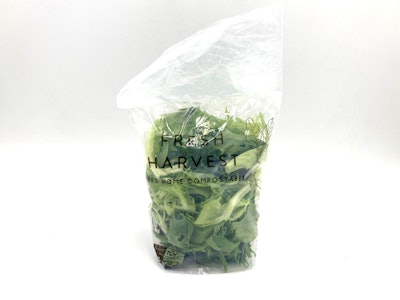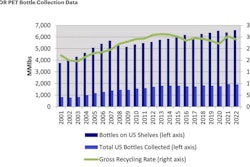
Since starting its organic produce and grocery delivery service more than a decade ago, Fresh Harvest, based in Clarkston, Ga., has been just as dedicated to minimizing packaging waste as it has been to ensuring the origin and quality of its products.
In 2012, a small group of friends wanting to create an ethical food hub in Georgia founded Fresh Harvest. The company collaborates with local farmers and suppliers to deliver sustainably sourced fresh produce, meat, dairy, and other products to around 3,200 customers in the greater Atlanta area every week.
 | Read this related article, “Compostable Packaging: ‘A Solution, Not Every Solution’” |
According to Fresh Harvest, it is committed to a “no-waste” mentality across both its food and packaging. “We purchase and deliver according to exact orders and nothing more, reducing food waste,” it says. “At the end of each week, our coolers are empty, and fresh produce arrives the following week.”
A no-waste mentality around packaging means Fresh Harvest delivers its products in reusable packaging, with returnable, reusable packaging components inside. It also means no single-use plastic for a number of Fresh Harvest’s produce offerings. Instead, the company has adopted compostable film from TIPA that it uses not only to package the produce, but also to nourish the soil the products are grown in when the material has reached its end of life.
Fresh Harvest addresses single-use plastic film
Fresh Harvest offers its fresh food products through subscriptions. Customers can choose from a variety of customizable Produce Baskets, each with different items. Options include Georgia Grown, Mixed Fruit and Veggies, Vegetable, Fruit, and Office Baskets. Customers can then add other food products to the box each week.
The “basket” itself is a reusable green plastic bin, with reusable four-ply ice packs from Herolily and reusable foil insulation inside that keep the products cold—a packaging system that Fresh Harvest has used since the beginning. The company also uses recyclable, compostable kraft paper on the bottom of the bins to protect more sensitive products from the ice packs.
“Each week, our team picks up our customers’ bins along with the ice packs and insulating foil, which are washed and reused for the next delivery,” explains Fresh Harvest CEO Alison Burnett. “With around 3,200 deliveries each week, that’s 3,200 fewer cardboard boxes, ice packs, and insulating foils filling up our recycling centers and landfills. While we’ve added new green Fresh Harvest bins as our customer base has expanded, our original bins are still in rotation.”
In 2021, Fresh Harvest began exploring ways to eliminate single-use plastic packaging from its operations. “We felt it was an important decision to add value to our service,” shares Burnett. “We can’t fully care about regenerative, sustainable agriculture and the land itself if we are using single-use packaging in our operations. The packaging has to support the same ethos.”
 | Watch this related video: “Compostable Packaging: Innovation and Growth Driven by Brands and Consumer Demand” |
As an alternative, Fresh Harvest looked at compostable packaging. Its requirements for the material included the ability to transport and protect the products while also extending the life of the perishable produce. According to Burnett, the company first experimented with corn-based packaging, “but customers were dissatisfied with the compostable bags due to a fishy smell that originated inside the packaging,” she says.
New film mirrors conventional material
The solution it landed on was a home- and industrially compostable film from TIPA. According to the supplier, it engineers the film from “a proprietary blend of fully compostable polymers, including both bio-based and fossil-based.” It adds, “This blend provides our films with a similar set of properties and capabilities of conventional plastic, so that brands can use compostable packaging for their chain of supply without compromising on quality or sustainability.”
Fresh Harvest is using premade bags made from TIPA 302, a single-ply, sealable, printable transparent film, to package loose, leafy greens, such as spinach, kale, salad mix, and arugula, as well as herbs, edible flowers, radishes, pea shoots, grapes, and an assortment of other seasonal items that it packs at its warehouse.
“We’ve also been using our purchasing power as a larger company to help drive the price down for our local farmers, who can buy the compostable bags at cost through us,” shares Burnett. Among the farmers taking advantage of the reduced cost are Rodgers Green & Roots Organic Farm in Douglasville, Ga., and Roots & Crystal Organic Farm in Newborn, Ga., which use the compostable bags for the produce they sell to Fresh Harvest as well as other channels.
A circular system for compostable packaging
Compostable packaging doesn’t fulfill its potential unless it’s actually composted. That’s why Fresh Harvest has clearly labeled the premade bags as compostable and advises customers to either compost the materials themselves or put the empty packaging into the reusable bin for return to the Fresh Harvest warehouse. Other messaging includes a sustainable packaging guide on Fresh Harvest’s website-based blog, and regular emails and other communications to customers throughout the year.
To handle the compostable packaging waste, Fresh Harvest partnered with local composting company CompostNow. “Both companies [Fresh Harvest and CompostNow] share similar values, so it’s been a natural partnership as we serve the same city,” says Burnett. “Many of our customers utilize both services—to receive their produce and then dispose of their food waste and packaging.”
 Fresh Harvest offers a guide to customers on what to do with each packaging component in their Produce Basket once they are done with the products.
Fresh Harvest offers a guide to customers on what to do with each packaging component in their Produce Basket once they are done with the products.
After picking up the plastic bins from its customers after use, Fresh Harvest removes the compostable packaging waste and places it into bins from CompostNow, which collects the materials every few weeks. Burnett says the service costs “a few hundred a month.” To reduce costs, Fresh Harvest uses a local farm to compost its vegetable scraps.
Once CompostNow collects the compostable packaging, it mixes the material with food scraps to create compost. Local farmers and gardeners then use the compost to fertilize their crops. One of CompostNow’s customers is Fresh Harvest. “We can literally use the compost made from the packaging on our own farm to grow more vegetables,” says Burnett. “CompostNow delivers the finished compost to the Fresh Harvest garden to grow items for our Produce Baskets.”
Adds Burnett, the circular packaging system has struck a chord with Fresh Harvest’s customers. “We hear from customers every day who want to live plastic-free and use our services because they can’t find fresh produce from the grocery store that isn’t covered in plastic,” she says. “Our customers help hold us accountable to select the most sustainable packaging, and they are delighted with this transition. PW























